硬盘的分区
Linux为各种IDE设备分配了一个由hd前缀组成的文件。各种SCSI设备,则被分配了一个由sd前缀组成的文件,编号方法为拉丁字母表顺序。如第一个IDE设备(如IDE硬盘或IDE光驱),Linux定义为hda;第二个IDE设备就定义为hdb;下面以此类推。而SCSI设备就应该是sda、sdb、sdc等。USB磁盘通常会被识别为SCSI设备,因此其设备名可能是sda。
简单来说就是
| 设备 | 设备名称 |
|---|---|
| IDE | hda、hdb、hdc |
| SCSI | sda、sdb、sdc |
在 Linux中规定,每一个硬盘设备最多能有4个主分区(其中包含扩展分区)。任何一个扩展分区都要占用一个主分区号码。在一个硬盘中,主分区和扩展分区一共最多是4个。编号方法为阿拉伯数字顺序。需要注意的是,主分区按1234编号,扩展分区中的逻辑分区,编号直接从5开始,无论是否有2号或3号主分区。对于第一个IDE硬盘的第一主分区,则编号为hdal,而第二个IDE硬盘的第一个逻辑分区编号应为hdb5。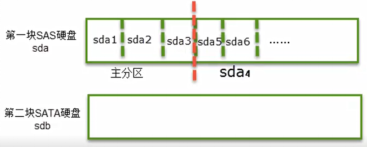
我们可以使用df命令用于显示目前在Linux系统上的文件系统的磁盘使用情况统计。
[root@localhost usr]# df -Th
Filesystem Type Size Used Avail Use% Mounted on
/dev/sda2 ext4 18G 3.3G 14G 20% /
tmpfs tmpfs 491M 224K 491M 1% /dev/shm
/dev/sda1 ext4 291M 34M 242M 13% /boot
第一列指定文件系统的名称,第三列指定一个特定的文件系统的总量。被使用的和可用的量使用列指定使用的内存的百分比,而最后一栏"安装在"指定的文件系统的挂载点。所谓的挂载点就是将磁盘的某个分区挂载到Linux某一个目录下以便访问。如第一个分区sda1(/dev/sda1)挂载到/boot目录下,第二个分区sda2(/dev/sda2)挂载到/目录下。
磁盘分区
下面我们可以对硬盘进行重新分区。和Windows一样,在Linux下用于磁盘分区的命令也是fdisk。注意磁盘分区操作会对数据造成损失,因此需要谨慎。
首先我们打开虚拟机设置
(1)右击虚拟机,选择“设置”菜单,打开“虚拟机设置”窗体。双击硬盘(SCSI)
(2)单击左下角的添加按钮,打开“添加硬件向导”窗体,单击下一步按钮。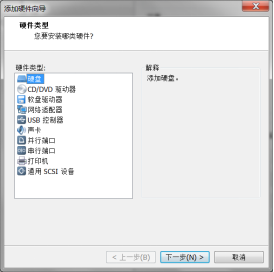
(3)选择磁盘类型和创建新虚拟磁盘。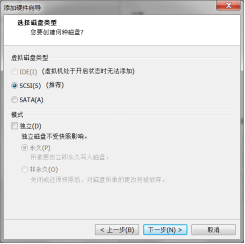
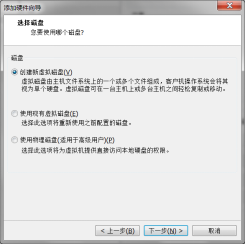
(4) 指定磁盘容量,将磁盘大小设置为5GB,选择磁盘存储为单个文件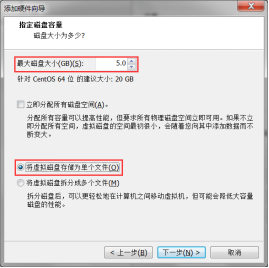
(5)将名称改为work.vmdk,单击完成按钮,完成磁盘的新建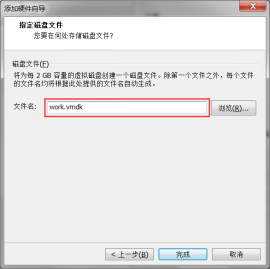
创建了一个新磁盘后,当前系统有两个硬盘。需要对sdb2硬盘进行分区和格式化。
然后使用fdisk命令的l选项查看硬盘分区
[root@localhost Desktop]# fdisk -l
Disk /dev/sda: 21.5 GB, 21474836480 bytes
255 heads, 63 sectors/track, 2610 cylinders
Units = cylinders of 16065 * 512 = 8225280 bytes
Sector size (logical/physical): 512 bytes / 512 bytes
I/O size (minimum/optimal): 512 bytes / 512 bytes
Disk identifier: 0x000b9729
Device Boot Start End Blocks Id System
/dev/sda1 * 1 39 307200 83 Linux
Partition 1 does not end on cylinder boundary.
/dev/sda2 39 2358 18631680 83 Linux
/dev/sda3 2358 2611 2031616 82 Linux swap / Solaris
Disk /dev/sdb: 5368 MB, 5368709120 bytes
255 heads, 63 sectors/track, 652 cylinders
Units = cylinders of 16065 * 512 = 8225280 bytes
Sector size (logical/physical): 512 bytes / 512 bytes
I/O size (minimum/optimal): 512 bytes / 512 bytes
Disk identifier: 0x00000000
当前虚拟机有两个磁盘,sda为原来的磁盘,有3个分区。sdb为刚创建的磁盘,没有分区。
再者对新建的磁盘sdb进行分区
[root@localhost Desktop]# fdisk /dev/sdb
......
输入m,查看帮助
Command (m for help): m
Command action
a toggle a bootable flag
b edit bsd disklabel
c toggle the dos compatibility flag
d delete a partition
l list known partition types
m print this menu
n add a new partition
o create a new empty DOS partition table
p print the partition table
q quit without saving changes
s create a new empty Sun disklabel
t change a partition's system id
u change display/entry units
v verify the partition table
w write table to disk and exit
x extra functionality (experts only)
选择n,添加一个新的分区
Command (m for help): n
Command action
e extended
p primary partition (1-4)
p
p是主分区,e是扩展分区。第一个主分区为sdb1,大小为2GB。我们现在选择创建主分区。
Partition number (1-4): 1
First cylinder (1-652, default 1):
Using default value 1
Last cylinder, +cylinders or +size{K,M,G} (1-652, default 652): +2G
创建好了主分区sdb1,接着创建一个扩展分区sdb2。
Command (m for help): n
Command action
e extended
p primary partition (1-4)
e
Partition number (1-4): 2
First cylinder (263-652, default 263):
Using default value 263
Last cylinder, +cylinders or +size{K,M,G} (263-652, default 652):
// 不填表示默认为剩下的所有空间都分配给sdb2
Using default value 652
Command (m for help): p
Disk /dev/sdb: 5368 MB, 5368709120 bytes
255 heads, 63 sectors/track, 652 cylinders
Units = cylinders of 16065 * 512 = 8225280 bytes
Sector size (logical/physical): 512 bytes / 512 bytes
I/O size (minimum/optimal): 512 bytes / 512 bytes
Disk identifier: 0x06e640c1
Device Boot Start End Blocks Id System
/dev/sdb1 1 262 2104483+ 83 Linux
/dev/sdb2 263 652 3132675 5 Extended
查看所有分区,打印分区表
Command (m for help): p
Disk /dev/sdb: 5368 MB, 5368709120 bytes
255 heads, 63 sectors/track, 652 cylinders
Units = cylinders of 16065 * 512 = 8225280 bytes
Sector size (logical/physical): 512 bytes / 512 bytes
I/O size (minimum/optimal): 512 bytes / 512 bytes
Disk identifier: 0x06e640c1
Device Boot Start End Blocks Id System
/dev/sdb1 1 262 2104483+ 83 Linux
/dev/sdb2 263 652 3132675 5 Extended
接着创建逻辑分区
Command (m for help): n
Command action
l logical (5 or over)
p primary partition (1-4)
l
First cylinder (263-652, default 263):
Using default value 263
Last cylinder, +cylinders or +size{K,M,G} (263-652, default 652):
Using default value 652
查看所有分区,打印分区表
Command (m for help): p
Disk /dev/sdb: 5368 MB, 5368709120 bytes
255 heads, 63 sectors/track, 652 cylinders
Units = cylinders of 16065 * 512 = 8225280 bytes
Sector size (logical/physical): 512 bytes / 512 bytes
I/O size (minimum/optimal): 512 bytes / 512 bytes
Disk identifier: 0x06e640c1
Device Boot Start End Blocks Id System
/dev/sdb1 1 262 2104483+ 83 Linux
/dev/sdb2 263 652 3132675 5 Extended
/dev/sdb5 263 652 3132643+ 83 Linux
现在共有3个分区,主分区sdb1,扩展分区sdb2,逻辑分区sdb5。输入w退出。
Command (m for help): w
The partition table has been altered!
Calling ioctl() to re-read partition table.
Syncing disks.
You have mail in /var/spool/mail/root
mkfs格式化分区
使用mkfs命令格式主分区sdb1,格式化文件系统为ext4。
[root@localhost Desktop]# mkfs -t ext4 /dev/sdb1
mke2fs 1.41.12 (17-May-2010)
Filesystem label=
OS type: Linux
Block size=4096 (log=2)
Fragment size=4096 (log=2)
Stride=0 blocks, Stripe width=0 blocks
131648 inodes, 526120 blocks
26306 blocks (5.00%) reserved for the super user
First data block=0
Maximum filesystem blocks=541065216
17 block groups
32768 blocks per group, 32768 fragments per group
7744 inodes per group
Superblock backups stored on blocks:
32768, 98304, 163840, 229376, 294912
Writing inode tables: done
Creating journal (16384 blocks): done
Writing superblocks and filesystem accounting information: done
This filesystem will be automatically checked every 24 mounts or
180 days, whichever comes first. Use tune2fs -c or -i to override.
使用mkfs命令格式逻辑分区sdb5,格式化文件系统为ext3。
[root@localhost Desktop]# mkfs -t ext3 /dev/sdb5
mke2fs 1.41.12 (17-May-2010)
Filesystem label=
OS type: Linux
Block size=4096 (log=2)
Fragment size=4096 (log=2)
Stride=0 blocks, Stripe width=0 blocks
195840 inodes, 783160 blocks
39158 blocks (5.00%) reserved for the super user
First data block=0
Maximum filesystem blocks=805306368
24 block groups
32768 blocks per group, 32768 fragments per group
8160 inodes per group
Superblock backups stored on blocks:
32768, 98304, 163840, 229376, 294912
Writing inode tables: done
Creating journal (16384 blocks): done
Writing superblocks and filesystem accounting information: done
This filesystem will be automatically checked every 28 mounts or
180 days, whichever comes first. Use tune2fs -c or -i to override.
格式化完成之后,就是将sdb1和sdb5挂载到/mnt目录下。
[root@localhost Desktop]# mount /dev/sdb1 /mnt/
[root@localhost Desktop]# mount /dev/sdb5 /mnt/
[root@localhost Desktop]# mount
如果出现如下字样
/dev/sdb1 on /mnt type ext4 (rw)
/dev/sdb5 on /mnt type ext3 (rw)
说明sdb1和sdb5已经挂载成功
如果想卸载挂载到mnt目录下的逻辑分区sdb5
[root@localhost Desktop]# umount /dev/sdb5